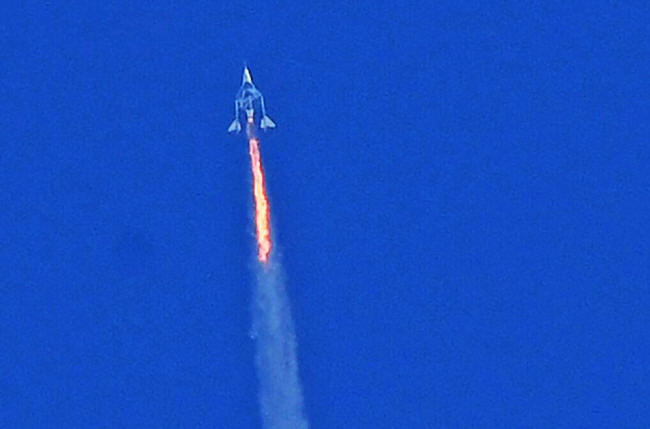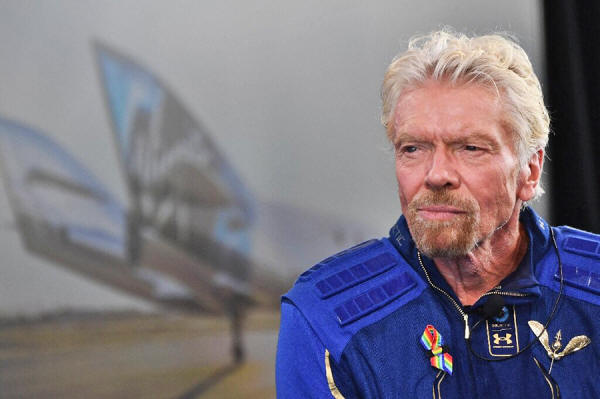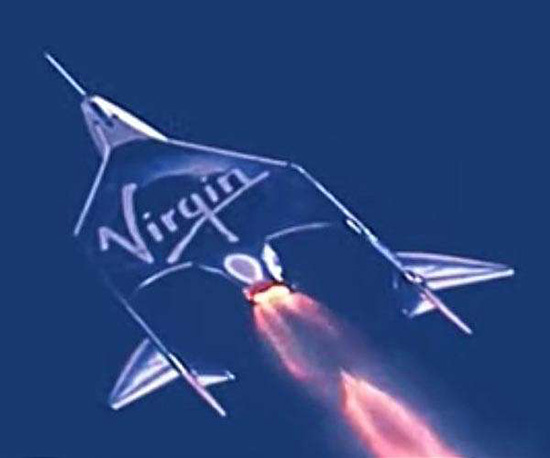|

by Lucie Aubourg and Issam Ahmed
September 02, 2021
from
PHYS Website

The vessel went
on to reach 85 kilometers (52 miles) in altitude
-
above the US definition of space - and landed safely,
but data retrieved from FlightRadar24 showed
it had flown outside its designated path.
The US Federal Aviation Administration (FAA) on Thursday said
it was grounding space flights by Virgin Galactic while it
investigates why the company's July mission carrying Richard
Branson deviated from its planned trajectory.
The move represents a blow to the space tourism firm as it prepares
to carry paying customers following its first fully-crewed test
flight.
"The FAA is
overseeing the Virgin Galactic investigation of its July 11
SpaceShipTwo mishap that occurred over Spaceport America, New
Mexico," the agency said in a short statement.
"Virgin Galactic may not return the SpaceShipTwo vehicle to
flight until the FAA approves the final mishap investigation
report or determines the issues related to the mishap do not
affect public safety," it added.
The company responded
with a statement saying:
"We take this
seriously and are currently addressing the causes of the issue
and determining how to prevent this from occurring on future
missions."
It added it was working
closely with the FAA,
"to support a
thorough review and timely resolution of this issue."
The FAA's decision came
after a report by The New Yorker said the flight experienced cockpit
warnings about its rocket-powered ascent that could have jeopardized
the mission.
The article, by investigative journalist Nicholas Schmidle,
said the pilots encountered first a yellow then a red light,
indicating the spaceplane's climb was too shallow and the nose was
insufficiently vertical:
On July 11th,
nearly a minute into the rocket trip carrying Richard Branson,
the British billionaire, to space, a yellow caution light
appeared on the ship's console.
The craft was about
twenty miles in the air above the White Sands Missile Range,
in New Mexico, and climbing, travelling more than twice the
speed of sound.
But it was veering
off course, and the light was a warning to the pilots that their
flight path was too shallow and the nose of the ship was
insufficiently vertical.
If they didn't fix
it, they risked a perilous emergency landing in the desert on
their descent.
Riding rockets is dangerous stuff. Around 1.4% of Russian,
Soviet, and American crewed spaceflight missions have resulted
in fatalities.
The foremost
commercial space companies - Branson's Virgin Galactic,
Elon Musk's SpaceX, and Jeff Bezos's Blue Origin -
must, over the coming years, bring that number down.
Their profits
depend on making frequent and safe human spaceflight a reality.
"A private
program can't afford to lose anybody," Branson has said...
Keep reading at The New Yorker...
Without corrective action, the vessel would not have had enough
energy to glide back to its runway.
"According to
multiple sources in the company, the safest way to respond to
the warning would have been to abort," Schmidle wrote - though
Virgin has disputed this.
Aborting would have
dashed flamboyant billionaire Branson's hopes of beating 'rival'
Jeff Bezos, whose own flight to space was scheduled a few
days later.
The pilots did not abort and instead attempted to correct for the
trajectory problem, now flying at Mach 3 with a red light on.
The vessel went on to reach 85 kilometers (52 miles) in altitude -
above the US definition of space - and landed safely, though
publicly available data showed it had flown outside its designated
path.

Richard Branson
after flying to space aboard a
Virgin Galactic vessel in July 2021.
Photo: Patrick Fallon/AFP via Getty Images
'Billionaire
bankroller'
"Whether or not (the
pilots') decision was motivated by programmatic pressures and
the hopes of their billionaire bankroller sitting in the back
remains unclear," wrote Schmidle.
Virgin Galactic told AFP
it disputed the,
"misleading
characterizations and conclusions in The New Yorker article."
"When the vehicle encountered high altitude winds which changed
the trajectory, the pilots and systems monitored the trajectory
to ensure it remained within mission parameters," it said in a
statement.
"Our pilots responded appropriately to these changing flight
conditions exactly as they have been trained and in strict
accordance with our established procedures."
The company acknowledged
the flight had "dropped below its permitted altitude" for one minute
and 43 seconds, but stressed:
"At no time did the
ship travel above any population centers or cause a hazard to
the public."
Virgin Galactic has had
close calls and accidents in the past - most notably in 2014 when a
crash killed one pilot and injured another.
Schmidle also wrote that key personnel who were critical of the
company's safety culture had resigned or been sacked.
Setback
Virgin Galactic's stocks fell immediately after the news but then
recovered slightly for a loss of three percent at the close of
business.
It was an abrupt change in fortune for the company that had been
riding high on what had appeared to be a resoundingly successful
flight, which Branson had described as the "experience of a
lifetime."
The 15-minute-long jaunt, together with Bezos' flight on a Blue
Origin rocket nine days later, seemed to have ushered in a lucrative
new era of space tourism after decades of development.
Last month, Virgin Galactic announced it was restarting ticket sales
at $450,000, around double the amounts paid by some 600 people who
previously booked seats.
It is unclear whether the next test flight, involving members of the
Italian Air Force, will take place as scheduled in late September or
early October.

| 



